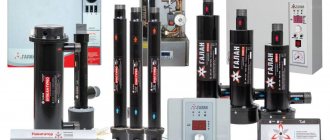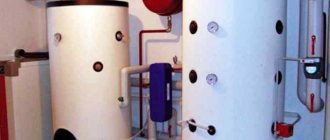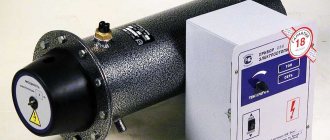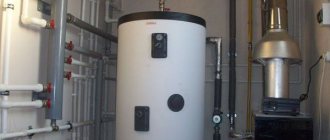The AGV boiler is a simple, but quite reliable and efficient heating device. The units have been produced since Soviet times, the products were called the Zhukovsky Machine-Building Plant. However, gradually all domestic autonomous gas devices began to be called by such an abbreviation.
Installation
The outer part of the chimney and the part located in the attic must be thermally and waterproofed.
It is necessary to install an inspection in the chimney designed to collect debris that has entered the chimney. Modern gas water heating installation.
Gas heaters can be connected to the gas pipeline and registered only by representatives of the regional gas industry. It is imperative to thermally insulate the pipeline through which the coolant will flow to the radiators. But it is not necessary to subject the return circuit to this procedure. If the house uses a heating circuit with natural circulation of coolant, the device should be mounted below the place where the radiators are installed. It is recommended to install it in the basement.
Installation of harness
In the process of installing gas heating, it is important to correctly set the angle of inclination of horizontal sections of the pipeline. The requirements include 1 cm of slope per 1 m of pipeline length
This allows for more efficient fluid circulation, reducing the likelihood of air locks. Providing the required slope will help drain water from the system if it is intended to preserve or repair individual elements.
AGV installation process.
The heating system will have a shorter service life if the temperature exceeds +50 °C, as this will cause condensation to form on the walls of the pipes and boiler. To improve the performance of systems using gas heat sources, heating can be supplemented with a circulation pump.
Aluminum or copper heat exchanger?
Among gas boilers, there are models with both the first and second heat exchanger. With copper it is still more common. An aggressive marketing policy convinced us that nothing could be cooler than copper. In general, this is true. But few people know that the efficiency of a boiler with an aluminum heat exchanger decreases by less than 1%. Therefore, if you come across an excellent boiler, then the heat exchanger in it is not copper, this is not a reason not to buy it.
But it is worth noting that by using an aluminum heat exchanger, the manufacturer is really trying to save money.
How it all began
At one time, gas boilers of the AGV-80 or AGV-120 brand were used to heat a private house. This equipment had low productivity, but given the low cost of gas, this fact did not bother anyone.
AGV gas boilers for private homes were equipped with primitive automation, which failed in the first year of operation. However, the equipment functioned normally without it.
Installation of pipes for distribution is carried out outside around the perimeter of the house. However, this issue was not relevant at that time, and heat was supplied to the house in full. Pipes were used with a diameter of 2 inches, since a smaller diameter could cause the formation of air pockets that impede the natural circulation of the coolant.
After a slight modernization, gas boilers for heating AOGV and AOKGV appeared on the market, but this equipment was characterized by the same shortcomings (low performance and unreliable automation).
Despite this, boilers of this type have held up quite confidently on the market due to a serious advantage: the AGV heating stove operates without being connected to a power supply.
Other advantages of a heating system using AGV include the following:
- If we compare imported equipment and AGV, we note the affordable cost of the latter option.
- In contrast to the AOGV and the gas boiler produced by domestic manufacturers, the efficiency of the AGV can be noted.
The listed characteristics help in deciding what is better: an AOGV or a boiler.
Criterias of choice
When buying boilers for a private home, several aspects are taken into account:
- The area of the heated room.
- Possible heat losses (depending on the materials from which the walls of the building are constructed, the floors and ceilings, windows and doors are made).
- Equipment power (the required figure is calculated based on 1 kW for every 10 m² of area). But if the house is located in a region with harsh winters or is built from materials with high heat loss, the resulting figure is increased by 25%.
- Functional features of the boiler.
AGVs are produced in different capacities, but the standard indicator is enough to heat a house up to 120 m². For large buildings, foreign autonomous boilers are purchased. Additionally, an improved AOGV or AKGV boiler is being considered as an alternative solution.
The latter is a complex water heating apparatus. These are double-circuit boilers that operate independently of the electrical network. The units provide heating and hot water supply.
However, experts believe that it is not advisable to install such equipment in houses with an area of 200 m² or more, since it is impossible to create stable natural draft. You will have to buy an additional circular pump, and a UPS and a generator for it to ensure operation. Such disadvantages offset the advantages that the autonomy of boilers provides.
Scheme of water heating of a country house
To heat country houses, heating systems are installed in which water or antifreeze acts as a coolant.
The system consists of the following components:
- Water heating boiler (with two or one circuit).
- Polypropylene or metal fittings and pipelines.
- Bypasses that allow you to turn off individual radiators without stopping the entire system.
- Cast iron, steel, bimetallic or aluminum batteries.
- Expansion tank.
- Circulation pump (only in systems with forced circulation of the coolant).
- Gas heating equipment must be equipped with a safety system, which includes a thermocouple and a solenoid valve.
Depending on the wiring diagram, such systems can be single-pipe or double-pipe. In the first case, heating devices are connected in series, so the temperature of the coolant in each subsequent device decreases. This wiring is suitable for small one-story houses.
With two-pipe wiring, coolant with the same temperature is supplied to each radiator, which ensures uniform heating of the entire house. If necessary, individual radiators can be disconnected from the general circuit. This wiring is ideal for a large house with several floors.
Depending on the principles of coolant flow, systems come with forced and natural circulation. With forced current, a circulation pump is responsible for the movement of liquid through the pipes, and natural circulation occurs due to the different densities of cold and hot liquid.
The expansion tank can be open or closed. For systems with natural circulation, an open type container is used. A closed tank with two sealed parts separated by a membrane, used in systems with forced liquid flow.
For small one-story buildings, systems with natural current are sufficient, but for buildings with several floors, a pump will have to be installed. In this case, the length of the circulation circuit is limited to 30 meters, because the pump will not be able to supply water over a greater distance.
You can also install combined heating. In such systems, the pump is installed on the bypass. It starts up when you need to quickly warm up the premises. If there are interruptions in the power supply, then by simply switching the levers you can switch to heating with natural circulation.
Double-circuit or single-circuit boilers?
This applies more to wall-mounted models. The recommendation here will be simple. If you have a small house with one bathroom and a kitchen, then take a double-circuit boiler and use hot water from it.
The main problem of double-circuit boilers is their low productivity. At the same time, such a device can provide one point of hot water. If there are several of them at once, problems may arise. For example, with a suddenly cold shower. Everyone has gone through it, everyone knows it and doesn’t want to repeat it. Therefore, it is better to install a boiler.
Composition of the AGV system
The AGV system for heating devices consists of the following main elements:
- AGV boiler;
- pipelines;
- heating elements (radiators, registers);
- expansion tank, which is mounted above all other elements (necessary when starting the AGV heating system).
The basis of the AGV is the AGV boiler. It is a tank mounted in an iron casing, inside of which a pipe for burning gas is mounted. It looks like a samovar. The combusted gas heats the water flowing inside the tank. Gas combustion products are released into the atmosphere through the chimney.
The heated water enters the heating system, where, in accordance with the known laws of physics—hot water is lighter than cold—it flows through pipelines into heating radiators. There, having given up thermal energy, it cools and again enters the AGV for heating. This creates a closed circuit through which the coolant flows by gravity. Its driving force is the difference in height between the heating (AGV) and cooling devices (radiators). The greater this difference, the more intense the water circulation. Such a heating system is called a thermosiphon or a system with natural circulation of coolant. However, recently heating systems with forced water circulation have become increasingly used. In this case, a circulation pump is installed at the outlet of the AGW into the pipeline, which significantly increases the rate of water circulation and, as a result, reduces the time for heating the premises at a given temperature and the consumption of gas consumed. In this case, automation is used that maintains the specified parameters and monitors the fulfillment of basic safety requirements (switching off the gas supply when the water pressure in the line decreases or the burners go out).
The difference between an expensive wall-mounted boiler and a cheap one
In fact, for the main task - heating your room, you can easily choose the most budget wall-mounted gas boiler of brand X rather than the same brand, but from a more expensive segment. After all, their gas consumption will be absolutely the same.
Everything else is not always the necessary bells and whistles. Such as additional sound insulation, energy-efficient pump, functions, sophisticated display, etc.
Even now, in order to save money, they began to use tubes and connections made of composite materials in cheap boilers, and metal in more expensive ones. Whether this is good or bad, time will tell.
It is important to understand one thing: if you choose a boiler for the purpose of regular heating of the house, you can take even the simplest gas unit.
Model overview
Any AOGV is a single-circuit floor-standing device designed for heating a room. There is no second circuit in them. If you need hot water supply, you need to connect an indirect heating boiler. Based on AOGV, AKGV is produced - they have a built-in heat exchanger for hot water supply.
The burner is designed for natural gas. To convert the device to liquefied gas, you will need to change it and need a special nozzle. The manufacturer produces heaters with power from 11 to 29 kW. You can choose a modification for heating an area from 45 to 250 m². The estimated cost of ZhMZ boilers is 18-23,000 rubles.
AOGV-11.6 Economy
Floor-standing version. Household versions - 11-29 kW. Features of version 11.6:
- Efficiency 90%
- Open camera.
- Heats 100 m².
- 11,600 W.
- One circuit.
- Mechanical control.
- Convection type.
- Weight - 45 kg.
AOGV-23.2-3 Comfort
- Efficiency 88%
- Open firebox.
- Heats 200 m².
- 23.2 kW.
- One circuit.
- Mechanical control.
- Convection type.
- Weight - 52 kg.
But 23 Universal can be made in two variations: single-circuit and double-circuit. The non-volatile device is equipped with imported automatic equipment. Works on any type of gas. Modest dimensions, light weight - an ideal solution for creating autonomous heating.
AOGV-17.4-3 Universal
AOGV 17 belongs to the convection type. Floor-standing version. Open firebox.
- Efficiency 88%
- Area - 140 m².
- Power - 17.4 kW.
- Weighs 49 kg.
The abbreviation stands for “Gas Water Heating Apparatus”. The Zhukovsky plant is not their only producer. They are released:
- JSC "Borinskoe" (Moscow region). It produces devices in an expanded power range; there are models for 5, 6, 7, 9 and 11 kW. Next: from 11 to 23 kW.
- CJSC "Rostovgazoapparat" Produces options 11.6-35 kW.
- There are also imported versions - Beretta (Italy).
Zhukovsky MZ does not produce parapet boilers, but they can be found from other domestic manufacturers, for example, a device from the ROSS company. Parapet models have a closed combustion chamber, so they can be installed in an apartment. They do not require a separate room.
Example of a parapet device: ROSS AOGV-13P. This is a 2-circuit option. Heats up to 130 m². 13 kW. Efficiency - 90%.
AOGV-23.2-3 Comfort: Timofey U., Istra
It has been operating for six years now. Very cheap compared to what the Europeans offer. Quickly heats a house of 180 sq.m. It starts without problems. Over the 5 years of operation, the thermocouple had to be replaced once.
AOGV-11.6-3: Elena P., Kotlas
Cheap, that's why we bought it. Pros: compact, relatively quiet. Cons: everything is cheap, poor, as if it was assembled in a barn. Automation is just one name. The very next year it started to turn off on its own. And sometimes, on the contrary, it starts to “blaze” - something is burning inside, it smells of burnt plastic. And the masters cannot do anything. If I have money, I’ll buy something better, but not ZhMZ.
ZhMZ gas boilers are simple and reliable equipment, time-tested. They are adapted to Russian conditions and have an affordable price. In addition to the products of the Zhukovsky Metallurgical Plant, there are a lot of other manufacturers on the market that produce similar equipment, including double-circuit and parapet models. Everyone can choose the power that suits their home.
Foreign autonomous gas water heaters
Non-volatile boilers are popular. Imported units differ from AGV in a wide variety of models. However, more often these are floor heating devices. Wall-mounted options are rare.
But there is a variety like parapet non-volatile boilers. They can be installed on the floor or hung on the wall (but not higher than the window sill). There are models mounted on a vertical surface.
Imported non-volatile devices also differ in the materials from which the heat exchanger is made. For example, stainless steel, cast iron or copper. The latter is considered expensive, but also the most reliable and durable option. Copper is not used for the production of AGV.
The equipment of the Slovak brand Protherm is popular. The models are named after animals. The Protherm Bear 20 TLO boiler is considered practical and powerful. The device is equipped with a heavy cast iron heat exchanger.
The unit has a higher efficiency compared to AGV - about 90%. This model is suitable for heating a house with an area of up to 200 m² (excluding heat loss), although the power is 18 kW.
Among foreign devices, the Baxi boiler is popular. SLIM EF 1.22. The device is characterized by a high power of 22 kW, but the efficiency is lower than that of other imported units - 88%.
Operating principle
All AOGV boilers look like a single-circuit mechanism, which is equipped with an internal atmospheric burner. The maximum coverage of the heated surface in such boilers is ensured by the energy of the combustion gas. This happens thanks to special micro-torch burners.
At the bottom of the boiler, directly under the tank with the heat exchanger, there is a gas burner, with the help of which the water is heated. With a slight modernization of the device, it can be operated using liquefied gas.
The steel heat exchanger has a tubular configuration, which ensures high efficiency of the equipment. In the rear area of the gas boiler there are outlet and inlet fittings with a diameter of approximately 4 cm, intended for connecting a heat carrier. At the bottom of the device there is a return line, and at the top there is a so-called “direct” line.
The chimney has a diameter of about 120 mm and is connected to the top of the device.
The unit is controlled using a valve with electromagnetic properties and a thermostat lever. Sometimes boilers with piezo ignition or automatic start are produced. A thermocouple and a draft sensor are connected to the valve. The copper thermocouple controls the presence of fire at the igniter and is considered an important component of the boiler. The draft sensor is capable of shutting off the flow of gas if the draft decreases.
Kinds
There are different structural types of wall-mounted gas boilers. They are combined into groups according to certain characteristics.
By type and material of heat exchanger:
- separated. The primary heats the coolant, and the secondary prepares hot water. On cheap models they are made of stainless steel, more expensive models are equipped with copper components;
- bithermic. This is a heat exchanger whose design is close to the coaxial form (pipe in pipe). As a rule, such units are made of stainless steel. . Bithermic heat exchangers are more efficient and do not cause fluctuations in the temperature of the hot water supply, but they quickly fill with scale and are extremely difficult to clean.
By type of burners and combustion chambers:
- open (atmospheric). Combustion air is taken directly from the room, and smoke is removed according to the principle of stove draft;
- closed (turbocharged). Air is supplied using a special fan. It also provides excess pressure, displacing smoke into the chimney.
According to the method of transferring thermal energy:
- convection The coolant is heated normally in the burner flame;
- condensation This is a relatively new two-stage heating technology. First, the coolant is heated in a condensation chamber, where thermal energy from the deposition of water vapor from the flue gases is used. The liquid then enters the primary heat exchanger, where it is brought to the desired state in the usual way.
Condensing boilers are almost twice as expensive as conventional boilers. but can only work under certain conditions. In particular, the difference in temperature inside and outside the room should not exceed 20°, which is only possible in warm countries.
By type of power supply:
- volatile. Units whose many components require power supply are fans. pumps, control boards, etc.;
- non-volatile. These are boilers that operate only on a mechanical principle (like a gas stove). They can be used in remote villages that do not have a network connection.
Many models of wall-mounted gas boilers have various additional functions:
- possibility of remote control. The units have a module for Internet access and can be configured from anywhere in the world via a smartphone application;
- climate sensors. This function allows you to adjust the boiler operating mode in case of sudden changes in outside temperature;
- connecting a room thermostat. Controlling the operation of the boiler with priority to external sensors allows you to save fuel and provide more comfortable indoor conditions.
IMPORTANT!
Many functions that are available on expensive boiler models are almost never used. When purchasing, you need to decide whether it is advisable to overpay for unnecessary features. There is always the opportunity to buy exactly the boiler that will be used to its fullest extent.
DEVICE AND PRINCIPLE OF OPERATION.
The device consists of the following components and parts: a heat exchanger tank, a main burner, an ignition burner unit with a thermocouple and an ignition electrode installed in it, a combined gas valve (multifunctional regulator), a draft stabilizer, and cladding parts.
In the upper part of the tank-heat exchanger there is a thermostat sensor connected by a capillary tube to the actuator of the thermostatic valve (bellows-thermal balloon system), and a thermometer sensor
A special feature of the design of the 630 EUROSIT combination valve is the presence of a device for stabilizing the gas outlet pressure, as well as the combination of valve control in one handle with the designation of positions by the corresponding symbols and numbers at its end and an indicator on the valve cover. The dependence of the temperature of the heated water on the position of the control handle scale is presented below:
| Scale numbers | 1 | 2 | 3 | 4 | 5 | 6 | 7 |
| Water heating temperature, °C | 30 | 40 | 50 | 60 | 70 | 80 | 90 |
The operating principle of the temperature controller is based on the expansion of liquid when heated. The working fluid, heated in the sensor (thermal cylinder) from the water in the tank - heat exchanger, heated by the combustion of natural gas, expands and flows through the capillary tube into the bellows, which converts the volumetric expansion into linear movement of the mechanism that drives the system of two valves (instantaneous and metering). ). The design of the mechanism provides protection against thermal overload, which protects the bellows-thermal cylinder system from damage and depressurization.
- When setting the required water temperature in the device using the control handle to increase, first the instantaneous (click) valve opens, then the dosing valve.
- When the water temperature in the apparatus reaches the set value, the dosing valve smoothly closes, switching the main burner to the “low gas” mode.
- When the temperature rises above the set value, an instantaneous (click) valve is activated, completely shutting off the gas to the main burner.
- In the absence of draft in the chimney, the gases leaving the firebox heat the draft sensor, the sensor is triggered, opening the normally closed contacts of the thermocouple circuit. The electromagnetic (inlet) valve closes and blocks the access of gas to the main and ignition burners. The draft sensor is designed to be activated during a period of no draft for at least 10 seconds.
- When the gas supply from the network is stopped, the pilot burner instantly goes out, the thermocouple cools down, and the solenoid valve closes, blocking gas access to the main and pilot burners. When the gas supply is restored, the passage through the apparatus is completely blocked.
- When the gas pressure in the network decreases below 0.65 kPa, the gas pressure at the ignition burner will also drop, and the emf of the thermocouple will decrease to a value insufficient to hold the valve. The solenoid valve will close and block gas access to the burners.
Speaker repair
AGV – 80 gas heating boiler. Technical characteristics of agv-80:
- Heat load 6000kcal/h
- Water temperature setting 40 - 90gr/C
- Heated room area up to 60m2
Main components of the AGV-80 heating boiler.
- Galvanized tank (80 liters), thermal insulation, min. cotton wool. In the center of the tank is a flame tube with a heat flow extender.
- The main burner, in front of it, the tap regulates the gas supply.
- Automatic security.
- For flame, solenoid valve, thermocouple, igniter.
- For draft, tee, connected pipe, draft sensor.
- Temperature-thermostat.
Boiler solenoid valve. The boiler solenoid valve consists of two parts: gas and electromagnetic. There is a membrane between them. The thermocouple consists of two metals, chromel and copel, welded together. The flame heats the boiler thermostat, generating an electric current that magnetizes the core. By pressing the start button, the armature is pressed against the core by a pusher, while the paired valves move inside the gas part, opening the gas to the boiler igniter and compressing the return spring. At the end of the thermocouple warming up for 60 seconds, you must smoothly release the boiler button; under the action of the return spring, the paired valves are shifted back - 2.3 mm. Gas opens to both the igniter and the main burner of the boiler. The valve cannot return completely to its original position. They are held by an anchor magnetized to the core. If the igniter goes out, then the thermocouple of the heating boiler cools down and the magnet releases the armature; the return spring pushes the valve to its original position, no gas flows to the burner.
Malfunctions of the gas heating boiler AGV-80
- Contamination of the surface of the core and armature (clean, degrease)
- Thermocouple burnt out (Replace)
- No electrical contact.
Automatic traction (with gas removal from the igniter)
Gas from the electromagnetic valve of the heating boiler flows through the tee to the igniter, as well as through the connecting tube to the draft sensor installed under the hood of the device. The draft sensor is a bimetallic plate with a plug, which, during normal draft, closes the gas from the connecting tube. When the draft is covered, combustion products come out from under the hood and heat the bimetallic plate. It unbends, the plug opens the gas from the connecting tube, and gas is supplied to the igniter. Response time from 10 to 60 seconds.
Gas boiler thermostat. Operation accuracy 5gC, thermostat parts.
- Frame.
- Toggle lever system.
- Valve with spring.
- A brass tube with an invectar rod is screwed into it.
- Lever for thermostat.
When the water in the tank is heated, the brass tube lengthens, but the intar rod does not. The rod moves behind the tube and stops pressing on the system of closed levers, which, under the action of a spring, closes the valve with a click, blocks the passage of gas to the burner; when the water cools, the brass tube shortens; the rod presses on the levers, they close and turn off the valve. When the setting lever is rotated counterclockwise, the response temperature increases.
Malfunction of the boiler thermostat.
- The thermostat does not work and cannot be adjusted: The lever system has stretched or burst.
- The large or small levers are deformed.
- The supporting edges of the levers are worn
The thermostat operates but does not stop the gas supply: The valve stem sets the guide bushing.
AGV, or automatic gas water heater, is an element of the heating system, thanks to which it becomes easy to operate along with a fairly long service life. However, the presence of these characteristics is possible only if the gas boiler is properly installed and properly maintained.
Epilogue
In conclusion, it is worth recalling that the repair of AGV, along with the maintenance of gas boilers, are quite difficult operations that must be carried out by specialists. Only by observing this condition can the risk of damage to housing and injury to its inhabitants be eliminated.
Repair of AGV, OAGV, gas heating boilers 8-903605-49-99
Design Features
- Fire adjustment is made in two ways: automatically and manually. The models differ not only in power, each of them has a certain range of capabilities.
- Some models have a pump to circulate water in the pipes. This allows you to effectively heat the room due to uniform heat distribution. Cheaper modifications do not have pumps, and water circulates according to the laws of physics. Therefore, when installing such boilers, the pipes are mounted at an angle.
- All modifications have an expansion tank. It allows you to achieve optimal pressure in the system, and if the liquid expands due to strong heating, it stores its excess.
Varieties
All boilers at the Zhukovsky Plant are floor-standing. There are three modifications:
In the first case, automation manufactured in the Russian Federation was used, in the other two - foreign ones. The brand presents only single-circuit versions - for heating buildings; double-circuit versions are not produced at ZhMZ.
Device
The efficiency of the equipment is 89%, which is quite good for domestic products. This productivity can be achieved due to the original design of the heat exchanger. The cast iron heat exchanger is equipped with turbulators. The burner is atmospheric, air comes from the room. Thanks to automation, continuous operation for a long time is ensured.
Heaters from the Zhukovsky Plant have a number of innovations that increase their environmental friendliness. Developers are trying to keep up with global trends, but still, domestic products are far from achieving the indicators of European and some Asian competitors. But Russian products have an undeniable advantage - a low price that satisfies all consumers.
Boiler with the best gas consumption
When comparing gas boilers with each other, you will probably ask the seller: “what gas consumption will my 100-square-meter house have with your boiler?” The seller of brand X boilers will tell you that the consumption will be 5-6 cubic meters per day, and the seller of brand Y will give a figure of 7-8 cubic meters. You will be happy to buy the one in which the consumption will be less.
Do you know what your mistake will be? The fact is that you asked this question at all. Because not a single seller will give the correct gas consumption figure. Today, the reality is that gas consumption depends not so much on the boiler, but on the heat loss of your home. And every home will have their own!
The boiler itself performs the function of compensating for heat loss. From here, remember the main thing: when choosing a gas boiler in the same price segment from classmates, you will get similar gas consumption. Now these figures have long been equal for all brands. Therefore, you don’t have to worry too much about consumption.
Advantages and disadvantages of AGV
Like any device, AGV also has its advantages and disadvantages. Its main advantages are:
- reliability and safety during operation;
- independence from power supply;
- possibility of heating automation;
- the use of various installation methods (wall or floor);
- simplicity of design, which allows for high-quality and reliable maintenance of the equipment;
- low cost and economical operation.
There are two main disadvantages:
- some massive equipment, which occupies about 1 m3. Therefore, AGVs are often installed in a separate room.
- deterioration of the design of heated rooms (pipes, radiators or registers), which forces the use of additional elements when arranging the interior.
Manufacturers
If you want to purchase a higher quality and more expensive AGV, you can pay attention to the products of foreign companies:
- BAXI and FERROLI. These devices have a good design and an electronic control unit.
- RINNAI. Devices of this brand are distinguished by quality, reliability and ease of use.
- ANIERIA. Relatively inexpensive, but very reliable boilers made in Korea.
Imported devices outperform domestic ones in efficiency, but lose due to their dependence on electricity. Before you turn on a foreign-made AGV, you need to connect it to the power grid. Considering that there are often power outages in the domestic space, this factor cannot be ignored when choosing a suitable device.
The choice of AGV is often based on the cost of equipment and operation. Domestic-made boilers are cheaper on their own, and they are much more profitable to operate. The total savings are approximately a third, based on similar indicators of imported devices.
Modern heating AGV
Compared to Soviet models, manufactured devices have become convenient and functional. They are equipped with automation, which makes the operation of the boilers comfortable for the user.
Modern models have a temperature sensor necessary to control the set temperature. Often a component is installed that regulates the draft in the chimney. The operation of the automation is carried out due to the electric current generated by a thermocouple. The latter produces it due to heating. This ensures the activity of the electromagnet, which makes it possible to control the gas valve. This also increases operational reliability.
To choose a suitable model, take into account the characteristics of the equipment.
SAFETY INSTRUCTIONS
Persons who have examined this passport are allowed to service the device.
Installation and operation of the devices must comply with the requirements of the “Rules for the design and safety of operation of hot water boilers, water heaters and steam boilers with excess pressure”, as well as the requirements of the “Safety Rules for Gas Distribution and Gas Consumption Systems. PB 12 - 529", approved by the State Mining and Technical Supervision of Russia.
The operation of the devices must be carried out in accordance with the “Fire Safety Rules for residential buildings, hotels, dormitories, administrative buildings and individual garages PPB - 01 - 03”.
Operation of the device is only permitted with properly functioning automatic safety and thermal control.
Gas safety automatics must provide:
- Reducing the gas supply when the water temperature in the heating system reaches the set value.
- Shutting off the gas supply to the main burner when the set heating temperature is exceeded.
- Turning off the gas supply to the device in the following cases:
- when the gas supply to the device is stopped (within no more than 60 seconds);
- in the absence of draft vacuum or in the boiler furnace (for a period of no less than 10 seconds and no more than 60 seconds);
- when the pilot burner flame goes out (within no more than 60 seconds).
When operating the device, the hot water temperature should not exceed 95 °C.
Prohibited:
- operate the device with the heating system partially filled with water;
- use other liquids instead of water as a coolant**;
- install shut-off and control valves on the supply line and pipeline connecting the heating system to the expansion tank;
- operate the device if there is a gas leak through the gas pipeline connections;
- use an open flame to detect gas leaks;
- operate the device if there is a malfunction of the gas network, chimney or automation;
- independently eliminate malfunctions in the operation of the device;
- make any design changes to the apparatus, gas pipeline and heating system.
When the device is not working, all gas valves: in front of the burner and on the gas pipeline in front of the device, must be in the closed position (the valve handle is perpendicular to the gas pipeline).
Any malfunctions when operating the device on gas must be immediately reported to the emergency service of the gas operating company.
If gas is detected in the premises, you should immediately stop supplying it, ventilate all premises and call emergency or repair services. Until the malfunction is eliminated, it is prohibited to light matches, smoke, or use
** It is allowed to use household coolant “Olga” (manufacturer: ZAO Organic Products Plant) according to the instructions for use. After a period of operation, the coolant must be drained and disposed of.
The manufacturer reserves the right to make changes to the design and appearance of the product. This technical documentation may differ from the description above; see the operating manual enclosed with each boiler upon purchase.
This page uses materials from the site
User manual
The main thing to remember is that such boilers do not have a built-in circulation pump. Good natural traction is required. This is only possible if ventilation is established in the room where the AGV is installed, and the chimney is arranged according to all the rules.
The installation features are as follows:
- the height of the air duct is at least 5 m with a total length of horizontal sections of up to 3 m;
- the diameter of the pipe corresponds to the size of the outlet pipe of the device;
- equipment must not be connected to exhaust ventilation ducts;
- a small hatch is installed under the vertical part of the chimney to clean the system from condensate;
- When installing the AGV, you need to make sure that there is a free passage of at least 1 m in front of the device.
The recommended distance from the unit to the nearest wall is 2 m or more; this is the only way to ensure fire safety. The finishing of the vertical surface must be made of non-combustible material. If the owner doubts its properties, it is better to install a screen made of sheet asbestos.
Installation of AGV necessarily involves connecting the equipment to gas networks. You cannot do this on your own; you need to contact specialists from a company that has a license to carry out the work.
As for the operating rules, the equipment is started in the following sequence:
- First you need to check whether the heater tank is filled with water.
- Then they look for the presence of draft in the chimney. This can be done using a thin paper flag. If there is no traction, it will remain motionless. This is important because there is a risk of poisoning from unburned fuel.
- Open the valve mounted on the gas pipeline.
- Light the burner (with a match or piezo ignition handle - depending on what type is provided on the model). Then only the igniter turns on. After this, you can open the tap in front of the main burner. It should work from the igniter. It is recommended to read the instructions first.
- After turning on the AGV, check again for the presence of draft in the chimney.
- Close the firebox door.
If the igniter goes out, it can only be re-ignited after a few minutes. When the water heater is running, it should be on constantly.
The AGV is also switched off sequentially. First you need to close the gas valves. They are installed in front of the main burner and appliance. The AGV 120 gas boiler is characterized by the fact that the pilot valves in front of the boiler are closed separately.
The units do not require special care. The main thing is to provide protection from mechanical damage and liquid ingress if the device is installed in such a way that splashes from a shower stall or water tap reach it.
The operation of the device should be monitored. The flame has a bluish tint and the length of the tongues is 30-40 mm. If it starts to smoke, you need to open the windows slightly to allow oxygen to enter the system. When you smell gas in the air, call specialists immediately. Before the emergency team arrives, turn off the tap in front of the equipment and ventilate the room. At the same time, turn off electrical appliances and lights so that there is no spark anywhere.
What is AOGV: decoding
Mechanical automation.
AOGV (interpretation: gas hot water heating apparatus) is a gas boiler that does not contain a single volatile element. That is, the unit can operate autonomously without electricity. They are usually installed where there is a central gas pipeline, but even in the absence of gas, you can change the burner, which will run on propane-butane. In the heater marking there are always numbers after the abbreviation - this is the maximum power. For example, AOGV 17 means that the maximum thermal power of the unit is 17 kW.
Main elements of the heater:
- automation;
- thermocouple;
- combustion chamber;
- heat exchanger;
- chimney.
The operation of the AOGV boiler is controlled by mechanical automation. Domestic heaters can be equipped with automatic equipment of their own (in cheaper models), European or American production. This is the heart of the heater; without automation, the boiler cannot operate. The second important element of the heater is a copper thermocouple. It is responsible for activating the solenoid valve, which shuts off the gas supply if the burner wick goes out.
Unlike modern parapet heaters, AOGV gas boilers are equipped with an open combustion chamber. The disadvantage of such chambers is that they take air from the room in which they are located to maintain the fire. The advantage is the ability to exhaust smoke through a regular chimney with natural draft; there is no need for an energy-dependent fan.
The heat exchanger is located at the top of the combustion chamber, directly above the burner. Each circuit has its own heat exchanger; the fluids in them do not intersect. That is, if the heater is intended not only for heating the room, but also for preparing hot water, then there will be two heat exchangers.
Let's consider the method for finding the above fault.
When repairing a gas boiler, testing begins with the “weakest link” of the automation device - the draft sensor. The sensor is not protected by a casing, so after 6...12 months of operation it becomes “overgrown” with a thick layer of dust. The bimetallic plate (see Fig. 6) quickly oxidizes, which leads to deterioration of contact.
The dust coat is removed with a soft brush. Then the plate is pulled away from the contact and cleaned with fine sandpaper. We should not forget that it is necessary to clean the contact itself. Good results are obtained by cleaning these elements with a special “Contact” spray. It contains substances that actively destroy the oxide film. After cleaning, apply a thin layer of liquid lubricant to the plate and contact.
The next step is to check the serviceability of the thermocouple. It operates in severe thermal conditions, since it is constantly in the flame of the igniter; naturally, its service life is significantly shorter than other elements of the boiler.
The main defect of a thermocouple is burnout (destruction) of its body. In this case, the transition resistance at the welding site (junction) increases sharply. As a result, the current in the Thermocouple - Electromagnet circuit.
The bimetallic plate will be below the nominal value, which leads to the fact that the electromagnet will no longer be able to fix the rod (Fig. 5).
Model overview
Any AOGV is a single-circuit floor-standing device designed for heating a room. There is no second circuit in them. If you need hot water supply, you need to connect an indirect heating boiler. Based on AOGV, AKGV is produced - they have a built-in heat exchanger for hot water supply.
The burner is designed for natural gas. To convert the device to liquefied gas, you will need to change it and need a special nozzle. The manufacturer produces heaters with power from 11 to 29 kW. You can choose a modification for heating an area from 45 to 250 m². The estimated cost of ZhMZ boilers is 18-23,000 rubles.
AOGV-11.6 Economy
Floor-standing version. Household versions - 11-29 kW. Features of version 11.6:
- Efficiency 90%
- Open camera.
- Heats 100 m².
- 11,600 W.
- One circuit.
- Mechanical control.
- Convection type.
- Weight - 45 kg.
AOGV-23.2-3 Comfort
- Efficiency 88%
- Open firebox.
- Heats 200 m².
- 23.2 kW.
- One circuit.
- Mechanical control.
- Convection type.
- Weight - 52 kg.
But 23 Universal can be made in two variations: single-circuit and double-circuit. The non-volatile device is equipped with imported automatic equipment. Works on any type of gas. Modest dimensions, light weight - an ideal solution for creating autonomous heating.
AOGV-17.4-3 Universal
AOGV 17 belongs to the convection type. Floor-standing version. Open firebox.
- Efficiency 88%
- Area - 140 m².
- Power - 17.4 kW.
- Weighs 49 kg.
The abbreviation stands for “Gas Water Heating Apparatus”. The Zhukovsky plant is not their only producer. They are released:
- JSC "Borinskoe" (Moscow region). It produces devices in an expanded power range; there are models for 5, 6, 7, 9 and 11 kW. Next: from 11 to 23 kW.
- CJSC "Rostovgazoapparat" Produces options 11.6-35 kW.
- There are also imported versions - Beretta (Italy).
Zhukovsky MZ does not produce parapet boilers, but they can be found from other domestic manufacturers, for example, a device from the ROSS company. Parapet models have a closed combustion chamber, so they can be installed in an apartment. They do not require a separate room.
Example of a parapet device: ROSS AOGV-13P. This is a 2-circuit option. Heats up to 130 m². 13 kW. Efficiency - 90%.
What functions does the Zhukovsky gas boiler AOGV 23 have?
The abbreviation AOGV 23 stands for Domestic Gas Heating Apparatus with a power of 23 kW. This is a single-circuit floor-standing unit capable of efficiently heating a room up to 200 m2.
Such possibilities are optimal for use in a private house, cottage or other premises. The boiler is designed to perform only one function, which allowed the manufacturer to eliminate all unnecessary parts and unused design elements.
This increased reliability and reduced the number of failures and breakdowns. In addition, a feature of AOGV 23 boilers is energy independence.
In the event of a sudden power outage, the boiler will continue to operate as usual, which is important in the Russian winter. This feature significantly increases the reliability of the home heating system. At the same time, the lack of power supply requires a specific location of the radiator system, since coolant circulation will occur naturally
At the same time, the lack of power supply requires a specific location of the radiator system, since the coolant will circulate naturally.
The combustion chamber of the boiler is of an atmospheric type, with air intake directly from the room and natural smoke removal using a stove-type draft.
Household antifreeze is used as a coolant, which increases the reliability of the heating system in severe frosts.
Features of installation of the AGV heating system
Installation and connection of AGV can only be carried out by specialists from the gas service of your locality. After installation, your gas water heater will be registered.
If you plan to install AGV heating, then you must provide for the following features:
- The heating boiler is installed in a separate room (boiler room);
- The pipe for exhaust gases must be installed outside, at a height not lower than the roof.
- The minimum diameter of the chimney pipe must be 135 mm;
- The outer part of the chimney must be insulated and insulated;
- The chimney is equipped with a special channel for collecting waste.
When using a system with natural heat circulation, it is necessary to ensure that the unit is located below the installation level of the radiators.
If you already know how to choose AGV heating, then you should be aware that the diameter of the pipes is selected based on the technical documentation of the equipment.
When laying heating system pipes, it is necessary to lay them at a certain angle of inclination. The slope should be 10 millimeters per 1 meter of pipe. The condition with a slope is necessary in order to avoid the appearance of air locks in the system, as well as to improve water circulation. Plus, it’s convenient when draining water from the system.
When the temperature reaches 50 degrees C, gas condensate may appear on equipment elements. Because of this, the service life of some system components may be reduced. Also, at this temperature, the coolant itself stops circulating.
Disadvantages of the AGV gas system
- The layout and installation of pipelines when using the AGV system requires strict adherence to the rules.
- It is not possible to automatically regulate and control the temperature in each individual room. This may be the reason for not the most efficient fuel consumption.
If the AGW system is used in a country house and you leave it in winter, then it is important not to forget to drain the water from the heating system. In principle, this can be avoided if you use special antifreezes that do not freeze even at sub-zero temperatures. Be careful when using such chemicals as they can be toxic.
You should be careful when using such chemicals as they can be toxic.
It is possible to significantly improve the AGV heating system by installing a circulation pump, which will increase the efficiency of your heating system.
More power - more gas consumption
When choosing a gas boiler, you may often be faced with the fact that there is no suitable boiler for your area. Let’s say your house is 80 square meters, and you only have boilers from 15 kW.
An inexperienced buyer will look for boilers with a power of around 10 kW. An experienced person will buy what he likes. After all, in fact, it makes no difference with what power reserve you use a gas boiler. Your expenses will be similar.
As mentioned above, the boiler’s task is to compensate for heat loss in the house. A more powerful unit will simply do this faster. And the consumption will be comparable.











